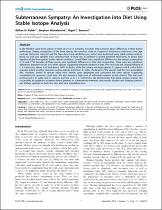JavaScript is disabled for your browser. Some features of this site may not work without it.
- ResearchSpace
- →
- Research Publications/Outputs
- →
- Journal Articles
- →
- View Item
| dc.contributor.author |
Robb, GN

|
|
| dc.contributor.author |
Woodborne, S

|
|
| dc.contributor.author |
Bennett, NC

|
|
| dc.date.accessioned | 2012-11-12T12:54:22Z | |
| dc.date.available | 2012-11-12T12:54:22Z | |
| dc.date.issued | 2012-11 | |
| dc.identifier.citation | Robb, GN, Woodborne, S and Bennett, NC. 2012. Subterranean sympatry: An investigation into diet using stable isotope analysis. Plos One Journal, vol. 7(11), pp10 | en_US |
| dc.identifier.issn | 1932-6203 | |
| dc.identifier.uri | http://hdl.handle.net/10204/6294 | |
| dc.description | Copyright: 2012 Robb et al. This is an open-access article distributed under the terms of the Creative Commons Attribution License, which permits unrestricted use, distribution, and reproduction in any medium, provided the original author and source are credited. | en_US |
| dc.description.abstract | In the Western Cape three species of mole-rat occur in sympatry, however, little is known about differences in their dietary preferences. Dietary composition of the three species; the common mole-rat (Cryptomys hottentotus hottentotus), the Cape mole-rat (Georychus capensis) and the Cape dune mole-rat (Bathyergus suillus) were examined using stable isotope analysis. Blood, fur and claw samples were collected from 70 mole-rats, in addition to several potential food items, to assess food selection of the three species under natural conditions. Overall there was a significant difference in the isotopic composition (d13C and d15N) between all three species and significant differences in their diet composition. There were also significant differences between tissues in all three species suggesting temporal variation in diet. The small size and colonial lifestyle of C. h. hottentotus allows it to feed almost 100% on bulbs, while the solitary and larger species G. capensis and B. suillus fed to a greater extent on other resources such as grasses and clover. B. suillus, the largest of the species, had the most generalized diet. However, overall all species relied most heavily upon geophytes and consumed the same species suggesting competition for resources could exist. We also showed a high level of individual variation in diet choices. This was most pronounced in B. suillus and G. capensis and less so in C. h. hottentotus. We demonstrate that stable isotope analysis can successfully be applied to examine dietary patterns in subterranean mammals and provide insights into foraging patterns and dietary variation at both the inter and intra population level. | en_US |
| dc.language.iso | en | en_US |
| dc.publisher | Public Library of Science | en_US |
| dc.relation.ispartofseries | Workflow;9842 | |
| dc.subject | Stable isotope analysis | en_US |
| dc.subject | Mole-rat species | en_US |
| dc.subject | Isotope modelling | en_US |
| dc.subject | Isotope composition | en_US |
| dc.subject | Dietary composition | en_US |
| dc.subject | Subterranean sympatry | en_US |
| dc.title | Subterranean sympatry: An investigation into diet using stable isotope analysis | en_US |
| dc.type | Article | en_US |
| dc.identifier.apacitation | Robb, G., Woodborne, S., & Bennett, N. (2012). Subterranean sympatry: An investigation into diet using stable isotope analysis. http://hdl.handle.net/10204/6294 | en_ZA |
| dc.identifier.chicagocitation | Robb, GN, S Woodborne, and NC Bennett "Subterranean sympatry: An investigation into diet using stable isotope analysis." (2012) http://hdl.handle.net/10204/6294 | en_ZA |
| dc.identifier.vancouvercitation | Robb G, Woodborne S, Bennett N. Subterranean sympatry: An investigation into diet using stable isotope analysis. 2012; http://hdl.handle.net/10204/6294. | en_ZA |
| dc.identifier.ris | TY - Article AU - Robb, GN AU - Woodborne, S AU - Bennett, NC AB - In the Western Cape three species of mole-rat occur in sympatry, however, little is known about differences in their dietary preferences. Dietary composition of the three species; the common mole-rat (Cryptomys hottentotus hottentotus), the Cape mole-rat (Georychus capensis) and the Cape dune mole-rat (Bathyergus suillus) were examined using stable isotope analysis. Blood, fur and claw samples were collected from 70 mole-rats, in addition to several potential food items, to assess food selection of the three species under natural conditions. Overall there was a significant difference in the isotopic composition (d13C and d15N) between all three species and significant differences in their diet composition. There were also significant differences between tissues in all three species suggesting temporal variation in diet. The small size and colonial lifestyle of C. h. hottentotus allows it to feed almost 100% on bulbs, while the solitary and larger species G. capensis and B. suillus fed to a greater extent on other resources such as grasses and clover. B. suillus, the largest of the species, had the most generalized diet. However, overall all species relied most heavily upon geophytes and consumed the same species suggesting competition for resources could exist. We also showed a high level of individual variation in diet choices. This was most pronounced in B. suillus and G. capensis and less so in C. h. hottentotus. We demonstrate that stable isotope analysis can successfully be applied to examine dietary patterns in subterranean mammals and provide insights into foraging patterns and dietary variation at both the inter and intra population level. DA - 2012-11 DB - ResearchSpace DP - CSIR KW - Stable isotope analysis KW - Mole-rat species KW - Isotope modelling KW - Isotope composition KW - Dietary composition KW - Subterranean sympatry LK - https://researchspace.csir.co.za PY - 2012 SM - 1932-6203 T1 - Subterranean sympatry: An investigation into diet using stable isotope analysis TI - Subterranean sympatry: An investigation into diet using stable isotope analysis UR - http://hdl.handle.net/10204/6294 ER - | en_ZA |






